2024年中考英语复习词法专题 名词课件(共21张PPT)
文档属性
| 名称 | 2024年中考英语复习词法专题 名词课件(共21张PPT) |  | |
| 格式 | pptx | ||
| 文件大小 | 985.2KB | ||
| 资源类型 | 教案 | ||
| 版本资源 | 通用版 | ||
| 科目 | 英语 | ||
| 更新时间 | 2024-05-24 08:24:05 | ||
图片预览


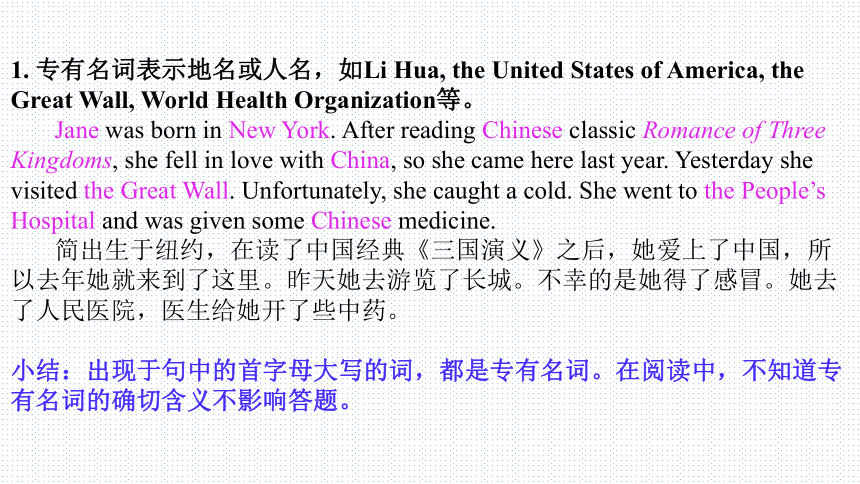
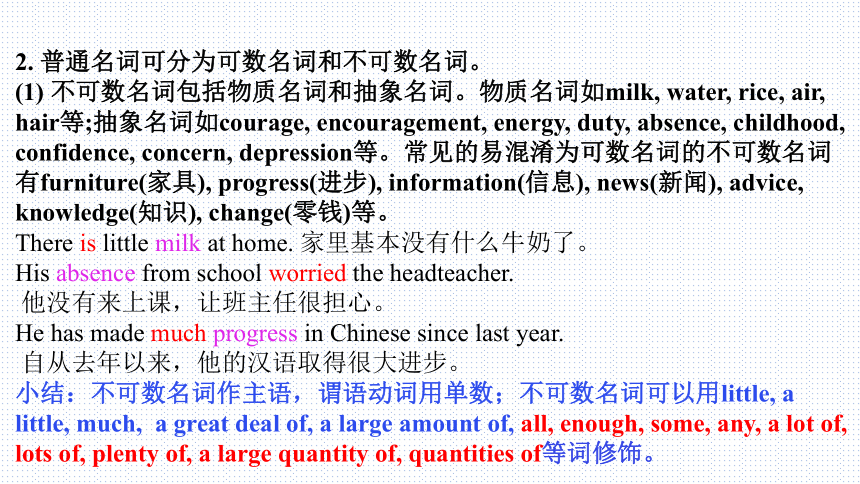
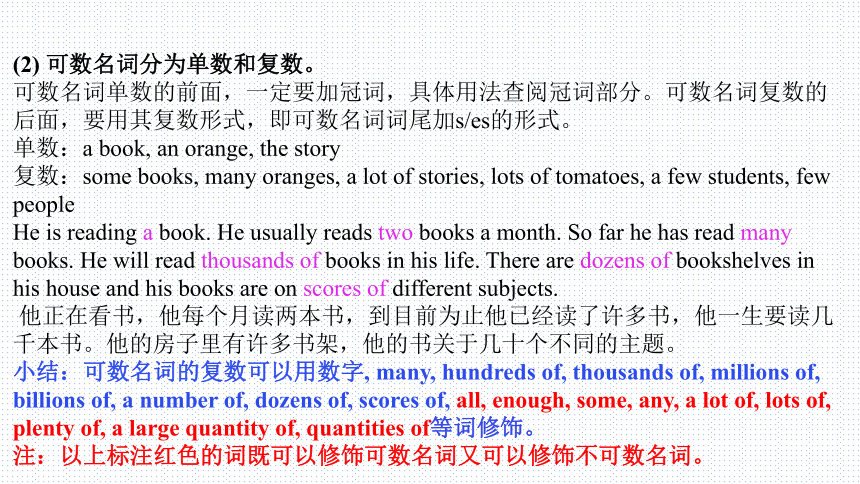
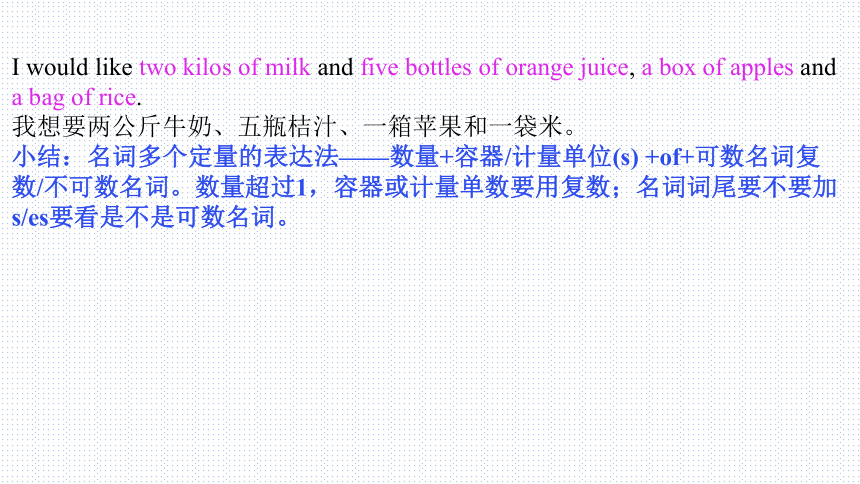
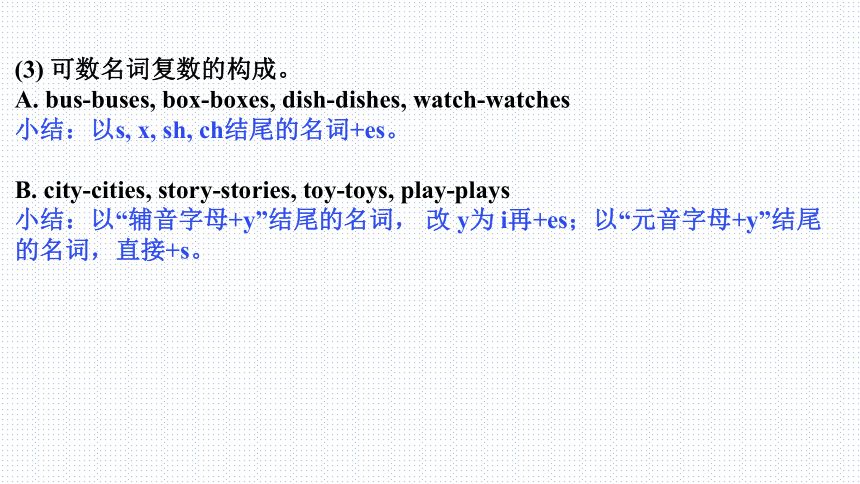
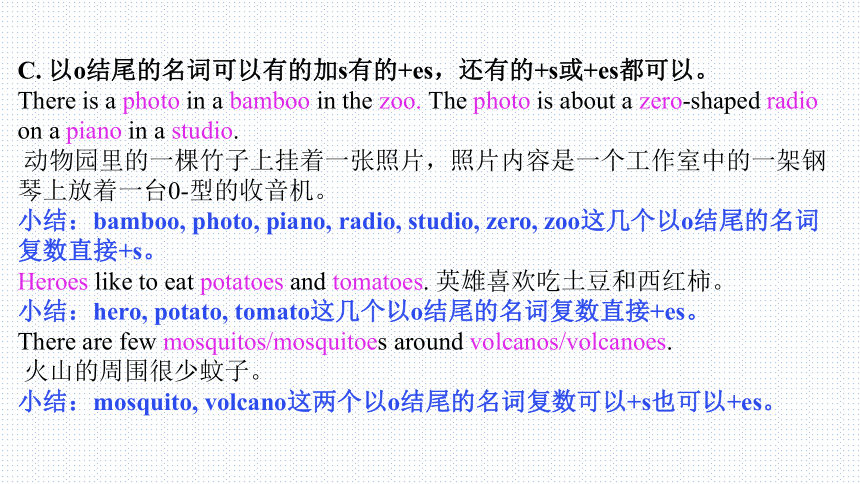
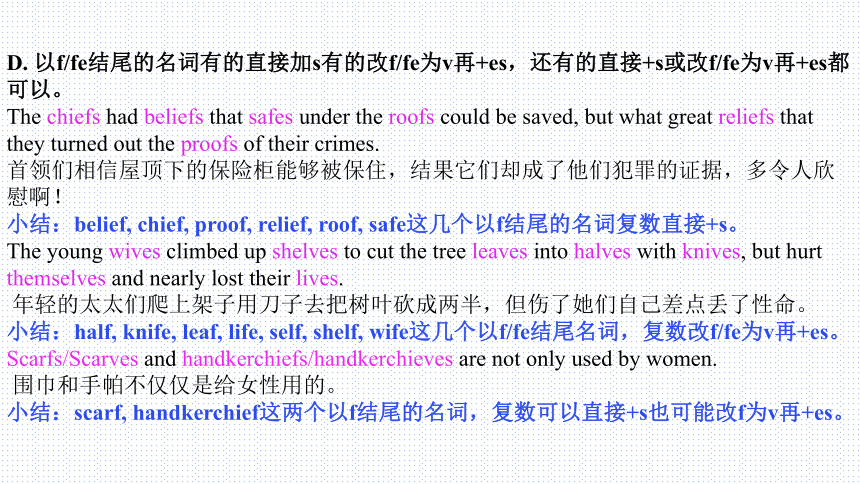
文档简介
(共21张PPT)
2024年中考英语复习词法专题★★
名 词
名词是表示人或事物的名称的词,可分为专有名词和普通名词。
名词的定义与分类
1. 专有名词表示地名或人名,如Li Hua, the United States of America, the Great Wall, World Health Organization等。
Jane was born in New York. After reading Chinese classic Romance of Three Kingdoms, she fell in love with China, so she came here last year. Yesterday she visited the Great Wall. Unfortunately, she caught a cold. She went to the People’s Hospital and was given some Chinese medicine.
简出生于纽约,在读了中国经典《三国演义》之后,她爱上了中国,所以去年她就来到了这里。昨天她去游览了长城。不幸的是她得了感冒。她去了人民医院,医生给她开了些中药。
小结:出现于句中的首字母大写的词,都是专有名词。在阅读中,不知道专有名词的确切含义不影响答题。
2. 普通名词可分为可数名词和不可数名词。
(1) 不可数名词包括物质名词和抽象名词。物质名词如milk, water, rice, air, hair等;抽象名词如courage, encouragement, energy, duty, absence, childhood, confidence, concern, depression等。常见的易混淆为可数名词的不可数名词有furniture(家具), progress(进步), information(信息), news(新闻), advice, knowledge(知识), change(零钱)等。
There is little milk at home. 家里基本没有什么牛奶了。
His absence from school worried the headteacher.
他没有来上课,让班主任很担心。
He has made much progress in Chinese since last year.
自从去年以来,他的汉语取得很大进步。
小结:不可数名词作主语,谓语动词用单数;不可数名词可以用little, a little, much, a great deal of, a large amount of, all, enough, some, any, a lot of, lots of, plenty of, a large quantity of, quantities of等词修饰。
(2) 可数名词分为单数和复数。
可数名词单数的前面,一定要加冠词,具体用法查阅冠词部分。可数名词复数的后面,要用其复数形式,即可数名词词尾加s/es的形式。
单数:a book, an orange, the story
复数:some books, many oranges, a lot of stories, lots of tomatoes, a few students, few people
He is reading a book. He usually reads two books a month. So far he has read many books. He will read thousands of books in his life. There are dozens of bookshelves in his house and his books are on scores of different subjects.
他正在看书,他每个月读两本书,到目前为止他已经读了许多书,他一生要读几千本书。他的房子里有许多书架,他的书关于几十个不同的主题。
小结:可数名词的复数可以用数字, many, hundreds of, thousands of, millions of, billions of, a number of, dozens of, scores of, all, enough, some, any, a lot of, lots of, plenty of, a large quantity of, quantities of等词修饰。
注:以上标注红色的词既可以修饰可数名词又可以修饰不可数名词。
I would like two kilos of milk and five bottles of orange juice, a box of apples and a bag of rice.
我想要两公斤牛奶、五瓶桔汁、一箱苹果和一袋米。
小结:名词多个定量的表达法——数量+容器/计量单位(s) +of+可数名词复数/不可数名词。数量超过1,容器或计量单数要用复数;名词词尾要不要加s/es要看是不是可数名词。
(3) 可数名词复数的构成。
A. bus-buses, box-boxes, dish-dishes, watch-watches
小结:以s, x, sh, ch结尾的名词+es。
B. city-cities, story-stories, toy-toys, play-plays
小结:以“辅音字母+y”结尾的名词, 改 y为 i再+es;以“元音字母+y”结尾的名词,直接+s。
C. 以o结尾的名词可以有的加s有的+es,还有的+s或+es都可以。
There is a photo in a bamboo in the zoo. The photo is about a zero-shaped radio on a piano in a studio.
动物园里的一棵竹子上挂着一张照片,照片内容是一个工作室中的一架钢琴上放着一台0-型的收音机。
小结:bamboo, photo, piano, radio, studio, zero, zoo这几个以o结尾的名词复数直接+s。
Heroes like to eat potatoes and tomatoes. 英雄喜欢吃土豆和西红柿。
小结:hero, potato, tomato这几个以o结尾的名词复数直接+es。
There are few mosquitos/mosquitoes around volcanos/volcanoes.
火山的周围很少蚊子。
小结:mosquito, volcano这两个以o结尾的名词复数可以+s也可以+es。
D. 以f/fe结尾的名词有的直接加s有的改f/fe为v再+es,还有的直接+s或改f/fe为v再+es都可以。
The chiefs had beliefs that safes under the roofs could be saved, but what great reliefs that they turned out the proofs of their crimes.
首领们相信屋顶下的保险柜能够被保住,结果它们却成了他们犯罪的证据,多令人欣慰啊!
小结:belief, chief, proof, relief, roof, safe这几个以f结尾的名词复数直接+s。
The young wives climbed up shelves to cut the tree leaves into halves with knives, but hurt themselves and nearly lost their lives.
年轻的太太们爬上架子用刀子去把树叶砍成两半,但伤了她们自己差点丢了性命。
小结:half, knife, leaf, life, self, shelf, wife这几个以f/fe结尾名词,复数改f/fe为v再+es。
Scarfs/Scarves and handkerchiefs/handkerchieves are not only used by women.
围巾和手帕不仅仅是给女性用的。
小结:scarf, handkerchief这两个以f结尾的名词,复数可以直接+s也可能改f为v再+es。
E. one yuan, thirty fen, five li, five dollars, ten pounds, twelve meters, twenty kilometers
小结:以汉语拼音形式出现的名词,单复数同形;国际通用的单位用复数形式。
F. Chinese, Japanese, Englishmen, Frenchwomen, Americans, Australians, Indians, Russians
小结:表示“某国人”遵循“中日不变英法变,其他国人加s”的原则。
G. Works here have adopted series of means to improve the head of sheep, fish and deer.
这里的工厂已采取了一系列的方法来提高鱼、绵羊和鹿的头数。
小结:series, means, sheep, fish, deer和 works表示“工厂”、head表示“牲口数”时,单复数同形。
(4)可数名词不规则变化的构成。
A. man-men男人 woman-women女人 child-children小孩
policeman-policemen男警察 Englishwoman-Englishwomen英国女人 mouse-mice老鼠 tooth-teeth牙齿 foot-feet脚
小结:以上这些名词的复数,需要特殊记忆。
B. basis-bases, analysis/ 'n l s s/-analyses, emphasis/'emf s s/-emphases, crisis-crises
小结:“基础危机,强调分析”这四个以sis结尾的名词,变为复数,改sis为ses读/s z/。
C. medium-media 媒体 gymnasium-gymnasia 健身房
datum-data 数据 stadium-stadia 体育场
phenomenon-phenomena 现象 criterion-criteria 标准
It’s a good phenomenon that the media pay attention to the data criteria of stadia and gymnasia.
媒体关注体育场和健身房的数据标准是一种好现象。
小结:以um/on结尾的名词,复数变为a。
(5) 复合名词变复数的方法。
passer-by---passers-by 过路人 looker-on---lookers-on 旁观者
小结:含主要名词的复合名词将其主要名词变为复数。
know-all---know-alls 万事通
小结:若复合名词没有主要名词,通常在最后一个词尾+s。
man nurse---men nurses 男护士 woman lawyer---women lawyers 女律师
小结:由man/woman与另一名词构成的合成名词,需将两者都变为复数。
注:除以上(4)(5)中所列出来的特殊情况外,其它可数名词的复数都是直接加s。
3. 名词所有格:表示句中不同名词之间的所有关系的语法形式叫名词所有格。
(1) 有生命的人或动物的名词所有格。
Father’s Day父亲节 Teachers’ Day教师节 Women’s Day妇女节
Children’s Day儿童节 a cat’s eyes一只猫的眼睛 the cats’ eyes多只猫的眼睛
They have a big house, so these are Lily’s and Lucy’s rooms.
他们有一座大房子,所以这两个是莉莉和露茜的房间。
They only have a small house, so this is Lily and Lucy’s room.
他们只有一座小房子,所以这个是莉莉和露茜的房间。
小结:有生命的人或动物的名词所有格,以s结尾的复数名词直接+’ ,不以s结尾的名词+’s; “A and B’s+可数名词单数”表示“两者共有一物”,“A’s and B’s+可数名词复数”表示“两者各自拥有一物”。
There’s nothing interesting on today’s newspapers.
今天的报纸没有什么有趣的新闻。
The house is about five minutes’ walk from my school.
那房子离我的学校五分钟的步行路程。
The town’s history dates back to 1500 years ago.
这个镇的历史可追溯到1500年前。
China’s ancient culture still has wide influence.
中国的古代文化仍然有广泛的影响。
The world’s population is becoming larger and larger. 世界人口越来越多。
We warmly welcomed our medical team’s return.
我们热烈欢迎我们的医疗队的归来。
The car’s paintwork is in good condition. 这台车的油漆状况良好。
小结:没有生命的部分名词如时间、距离、城镇、国家、世界、团体、机构、交通工具等的名词所有格,也是以s结尾的+’, 不以s结尾的+’s。
(2) 没有生命的名词的所有格用“of+后置定语”来表示。
Does anyone know the name of the novel
有人知道这部小说的名字吗?
There is a tall tree at the end of the road.
路的尽头有一棵大树。
One of the legs of the desk is broken.
桌子的一条腿坏了。
小结:没有生命的名词的所有格用“the+名词+of+后置定语”表示。
(3) 少部分无生命名词的所有格也可以用 “to+后置定语”来表示
On our way to a university, in reaction/response to my requirement, Peter told me something about his visit to China. He said people have no easy access to places of interest in his country and his had been trying to find a solution to the problem. When I asked him how he would approach it, he said building enough roads and bridges to these places was the answer to my question. He also said that it was his smooth passing through the entrance and the exit to a museum in China that gave him the key to the problem.
在我们去一所大学的路上,应我的要求,彼得给我谈了他的中国之旅的一些事。他说在他的国家,人们进入旅游景点很困难,他一直努力找这个问题的解决方案。当我问他如何解决这个问题时,他说建足够的通往这些地方的路和桥是我的问题的答案。他还说是他在中国的一次通畅地通过博物馆的入口和出口给了他问题的答案。
小结:answer, bridge, road, key, visit, way, entrance, exit, access, approach, reaction, response, solution这些词的所有格以“the+名词+to+后置定语”表示,其中way后面开始是高中词汇。
(4) 双重所有格:指名词’s/名词s’或名词性物主代词与of构成的所有格,即“of+名词所有格”。
a book of mine 我的一本书
a book of hers 她的一本书
a play of Shakespeare’s 莎士比亚的一部戏剧
a friend of my wife’s 我老婆的一位朋友
a patient of the doctor’s 这位医生的一个病人
a novel of the writer’s 这位作家的一部小说
小结:双重所有格中的名词必须为人,不能表示事物;该名词必须特指,不能泛指。
4. 名词在句中所充当的成分
A coat will keep you warm. 一件大衣能让你保暖。(主语)
I bought a coat yesterday. 我昨天买了一件大衣。(宾语)
I bought Jane a coat yesterday. 我昨天给简买了一件大衣。(间接宾语人、直接宾语物)
Would you like to try on the coat 您要试一下这件大衣吗?(介词宾语)
I named my cat Jemmy. 我把我的猫取名为杰米。(宾语补足语)
What I want is a coat. 我想要的是一件大衣。(表语)
There are two apple trees in our garden. 我们的花园里有两棵苹果树。(定语)
My friend, Jane, comes from England. 我的朋友简来自英国。(同位语)
小结:名词在句子中可以充当主语、宾语、宾语补足语、表语、定语和同位语。
5. 学习名词的重点:可数名词不可数名词以及它们的修饰词、可数名词的单复数、抽象名词与其它词的相互转化。
See you !
2024年中考英语复习词法专题★★
名 词
名词是表示人或事物的名称的词,可分为专有名词和普通名词。
名词的定义与分类
1. 专有名词表示地名或人名,如Li Hua, the United States of America, the Great Wall, World Health Organization等。
Jane was born in New York. After reading Chinese classic Romance of Three Kingdoms, she fell in love with China, so she came here last year. Yesterday she visited the Great Wall. Unfortunately, she caught a cold. She went to the People’s Hospital and was given some Chinese medicine.
简出生于纽约,在读了中国经典《三国演义》之后,她爱上了中国,所以去年她就来到了这里。昨天她去游览了长城。不幸的是她得了感冒。她去了人民医院,医生给她开了些中药。
小结:出现于句中的首字母大写的词,都是专有名词。在阅读中,不知道专有名词的确切含义不影响答题。
2. 普通名词可分为可数名词和不可数名词。
(1) 不可数名词包括物质名词和抽象名词。物质名词如milk, water, rice, air, hair等;抽象名词如courage, encouragement, energy, duty, absence, childhood, confidence, concern, depression等。常见的易混淆为可数名词的不可数名词有furniture(家具), progress(进步), information(信息), news(新闻), advice, knowledge(知识), change(零钱)等。
There is little milk at home. 家里基本没有什么牛奶了。
His absence from school worried the headteacher.
他没有来上课,让班主任很担心。
He has made much progress in Chinese since last year.
自从去年以来,他的汉语取得很大进步。
小结:不可数名词作主语,谓语动词用单数;不可数名词可以用little, a little, much, a great deal of, a large amount of, all, enough, some, any, a lot of, lots of, plenty of, a large quantity of, quantities of等词修饰。
(2) 可数名词分为单数和复数。
可数名词单数的前面,一定要加冠词,具体用法查阅冠词部分。可数名词复数的后面,要用其复数形式,即可数名词词尾加s/es的形式。
单数:a book, an orange, the story
复数:some books, many oranges, a lot of stories, lots of tomatoes, a few students, few people
He is reading a book. He usually reads two books a month. So far he has read many books. He will read thousands of books in his life. There are dozens of bookshelves in his house and his books are on scores of different subjects.
他正在看书,他每个月读两本书,到目前为止他已经读了许多书,他一生要读几千本书。他的房子里有许多书架,他的书关于几十个不同的主题。
小结:可数名词的复数可以用数字, many, hundreds of, thousands of, millions of, billions of, a number of, dozens of, scores of, all, enough, some, any, a lot of, lots of, plenty of, a large quantity of, quantities of等词修饰。
注:以上标注红色的词既可以修饰可数名词又可以修饰不可数名词。
I would like two kilos of milk and five bottles of orange juice, a box of apples and a bag of rice.
我想要两公斤牛奶、五瓶桔汁、一箱苹果和一袋米。
小结:名词多个定量的表达法——数量+容器/计量单位(s) +of+可数名词复数/不可数名词。数量超过1,容器或计量单数要用复数;名词词尾要不要加s/es要看是不是可数名词。
(3) 可数名词复数的构成。
A. bus-buses, box-boxes, dish-dishes, watch-watches
小结:以s, x, sh, ch结尾的名词+es。
B. city-cities, story-stories, toy-toys, play-plays
小结:以“辅音字母+y”结尾的名词, 改 y为 i再+es;以“元音字母+y”结尾的名词,直接+s。
C. 以o结尾的名词可以有的加s有的+es,还有的+s或+es都可以。
There is a photo in a bamboo in the zoo. The photo is about a zero-shaped radio on a piano in a studio.
动物园里的一棵竹子上挂着一张照片,照片内容是一个工作室中的一架钢琴上放着一台0-型的收音机。
小结:bamboo, photo, piano, radio, studio, zero, zoo这几个以o结尾的名词复数直接+s。
Heroes like to eat potatoes and tomatoes. 英雄喜欢吃土豆和西红柿。
小结:hero, potato, tomato这几个以o结尾的名词复数直接+es。
There are few mosquitos/mosquitoes around volcanos/volcanoes.
火山的周围很少蚊子。
小结:mosquito, volcano这两个以o结尾的名词复数可以+s也可以+es。
D. 以f/fe结尾的名词有的直接加s有的改f/fe为v再+es,还有的直接+s或改f/fe为v再+es都可以。
The chiefs had beliefs that safes under the roofs could be saved, but what great reliefs that they turned out the proofs of their crimes.
首领们相信屋顶下的保险柜能够被保住,结果它们却成了他们犯罪的证据,多令人欣慰啊!
小结:belief, chief, proof, relief, roof, safe这几个以f结尾的名词复数直接+s。
The young wives climbed up shelves to cut the tree leaves into halves with knives, but hurt themselves and nearly lost their lives.
年轻的太太们爬上架子用刀子去把树叶砍成两半,但伤了她们自己差点丢了性命。
小结:half, knife, leaf, life, self, shelf, wife这几个以f/fe结尾名词,复数改f/fe为v再+es。
Scarfs/Scarves and handkerchiefs/handkerchieves are not only used by women.
围巾和手帕不仅仅是给女性用的。
小结:scarf, handkerchief这两个以f结尾的名词,复数可以直接+s也可能改f为v再+es。
E. one yuan, thirty fen, five li, five dollars, ten pounds, twelve meters, twenty kilometers
小结:以汉语拼音形式出现的名词,单复数同形;国际通用的单位用复数形式。
F. Chinese, Japanese, Englishmen, Frenchwomen, Americans, Australians, Indians, Russians
小结:表示“某国人”遵循“中日不变英法变,其他国人加s”的原则。
G. Works here have adopted series of means to improve the head of sheep, fish and deer.
这里的工厂已采取了一系列的方法来提高鱼、绵羊和鹿的头数。
小结:series, means, sheep, fish, deer和 works表示“工厂”、head表示“牲口数”时,单复数同形。
(4)可数名词不规则变化的构成。
A. man-men男人 woman-women女人 child-children小孩
policeman-policemen男警察 Englishwoman-Englishwomen英国女人 mouse-mice老鼠 tooth-teeth牙齿 foot-feet脚
小结:以上这些名词的复数,需要特殊记忆。
B. basis-bases, analysis/ 'n l s s/-analyses, emphasis/'emf s s/-emphases, crisis-crises
小结:“基础危机,强调分析”这四个以sis结尾的名词,变为复数,改sis为ses读/s z/。
C. medium-media 媒体 gymnasium-gymnasia 健身房
datum-data 数据 stadium-stadia 体育场
phenomenon-phenomena 现象 criterion-criteria 标准
It’s a good phenomenon that the media pay attention to the data criteria of stadia and gymnasia.
媒体关注体育场和健身房的数据标准是一种好现象。
小结:以um/on结尾的名词,复数变为a。
(5) 复合名词变复数的方法。
passer-by---passers-by 过路人 looker-on---lookers-on 旁观者
小结:含主要名词的复合名词将其主要名词变为复数。
know-all---know-alls 万事通
小结:若复合名词没有主要名词,通常在最后一个词尾+s。
man nurse---men nurses 男护士 woman lawyer---women lawyers 女律师
小结:由man/woman与另一名词构成的合成名词,需将两者都变为复数。
注:除以上(4)(5)中所列出来的特殊情况外,其它可数名词的复数都是直接加s。
3. 名词所有格:表示句中不同名词之间的所有关系的语法形式叫名词所有格。
(1) 有生命的人或动物的名词所有格。
Father’s Day父亲节 Teachers’ Day教师节 Women’s Day妇女节
Children’s Day儿童节 a cat’s eyes一只猫的眼睛 the cats’ eyes多只猫的眼睛
They have a big house, so these are Lily’s and Lucy’s rooms.
他们有一座大房子,所以这两个是莉莉和露茜的房间。
They only have a small house, so this is Lily and Lucy’s room.
他们只有一座小房子,所以这个是莉莉和露茜的房间。
小结:有生命的人或动物的名词所有格,以s结尾的复数名词直接+’ ,不以s结尾的名词+’s; “A and B’s+可数名词单数”表示“两者共有一物”,“A’s and B’s+可数名词复数”表示“两者各自拥有一物”。
There’s nothing interesting on today’s newspapers.
今天的报纸没有什么有趣的新闻。
The house is about five minutes’ walk from my school.
那房子离我的学校五分钟的步行路程。
The town’s history dates back to 1500 years ago.
这个镇的历史可追溯到1500年前。
China’s ancient culture still has wide influence.
中国的古代文化仍然有广泛的影响。
The world’s population is becoming larger and larger. 世界人口越来越多。
We warmly welcomed our medical team’s return.
我们热烈欢迎我们的医疗队的归来。
The car’s paintwork is in good condition. 这台车的油漆状况良好。
小结:没有生命的部分名词如时间、距离、城镇、国家、世界、团体、机构、交通工具等的名词所有格,也是以s结尾的+’, 不以s结尾的+’s。
(2) 没有生命的名词的所有格用“of+后置定语”来表示。
Does anyone know the name of the novel
有人知道这部小说的名字吗?
There is a tall tree at the end of the road.
路的尽头有一棵大树。
One of the legs of the desk is broken.
桌子的一条腿坏了。
小结:没有生命的名词的所有格用“the+名词+of+后置定语”表示。
(3) 少部分无生命名词的所有格也可以用 “to+后置定语”来表示
On our way to a university, in reaction/response to my requirement, Peter told me something about his visit to China. He said people have no easy access to places of interest in his country and his had been trying to find a solution to the problem. When I asked him how he would approach it, he said building enough roads and bridges to these places was the answer to my question. He also said that it was his smooth passing through the entrance and the exit to a museum in China that gave him the key to the problem.
在我们去一所大学的路上,应我的要求,彼得给我谈了他的中国之旅的一些事。他说在他的国家,人们进入旅游景点很困难,他一直努力找这个问题的解决方案。当我问他如何解决这个问题时,他说建足够的通往这些地方的路和桥是我的问题的答案。他还说是他在中国的一次通畅地通过博物馆的入口和出口给了他问题的答案。
小结:answer, bridge, road, key, visit, way, entrance, exit, access, approach, reaction, response, solution这些词的所有格以“the+名词+to+后置定语”表示,其中way后面开始是高中词汇。
(4) 双重所有格:指名词’s/名词s’或名词性物主代词与of构成的所有格,即“of+名词所有格”。
a book of mine 我的一本书
a book of hers 她的一本书
a play of Shakespeare’s 莎士比亚的一部戏剧
a friend of my wife’s 我老婆的一位朋友
a patient of the doctor’s 这位医生的一个病人
a novel of the writer’s 这位作家的一部小说
小结:双重所有格中的名词必须为人,不能表示事物;该名词必须特指,不能泛指。
4. 名词在句中所充当的成分
A coat will keep you warm. 一件大衣能让你保暖。(主语)
I bought a coat yesterday. 我昨天买了一件大衣。(宾语)
I bought Jane a coat yesterday. 我昨天给简买了一件大衣。(间接宾语人、直接宾语物)
Would you like to try on the coat 您要试一下这件大衣吗?(介词宾语)
I named my cat Jemmy. 我把我的猫取名为杰米。(宾语补足语)
What I want is a coat. 我想要的是一件大衣。(表语)
There are two apple trees in our garden. 我们的花园里有两棵苹果树。(定语)
My friend, Jane, comes from England. 我的朋友简来自英国。(同位语)
小结:名词在句子中可以充当主语、宾语、宾语补足语、表语、定语和同位语。
5. 学习名词的重点:可数名词不可数名词以及它们的修饰词、可数名词的单复数、抽象名词与其它词的相互转化。
See you !
同课章节目录
- 词法
- 名词
- 动词和动词短语
- 动词语态
- 动词时态
- 助动词和情态动词
- 非谓语动词
- 冠词
- 代词
- 数词和量词
- 形容词副词及其比较等级
- 介词和介词短语
- 连词和感叹词
- 构词法
- 相似、相近词比较
- 句法
- 陈述句
- 一般疑问句和否定疑问句
- 特殊疑问句及选择疑问句
- 反意疑问句
- 存在句(There be句型)
- 宾语从句
- 定语从句
- 状语从句
- 主谓一致问题
- 简单句
- 并列句
- 复合句
- 主谓一致
- 主、表语从句
- 名词性从句
- 直接引语和间接引语
- 虚拟语气
- 感叹句
- 强调句
- 倒装句
- 祈使句
- 句子的成分
- 句子的分类
- 题型专区
- 单项选择部分
- 易错题
- 完形填空
- 阅读理解
- 词汇练习
- 听说训练
- 句型转换
- 补全对话
- 短文改错
- 翻译
- 书面表达
- 任务型阅读
- 语法填空
- 其他资料
